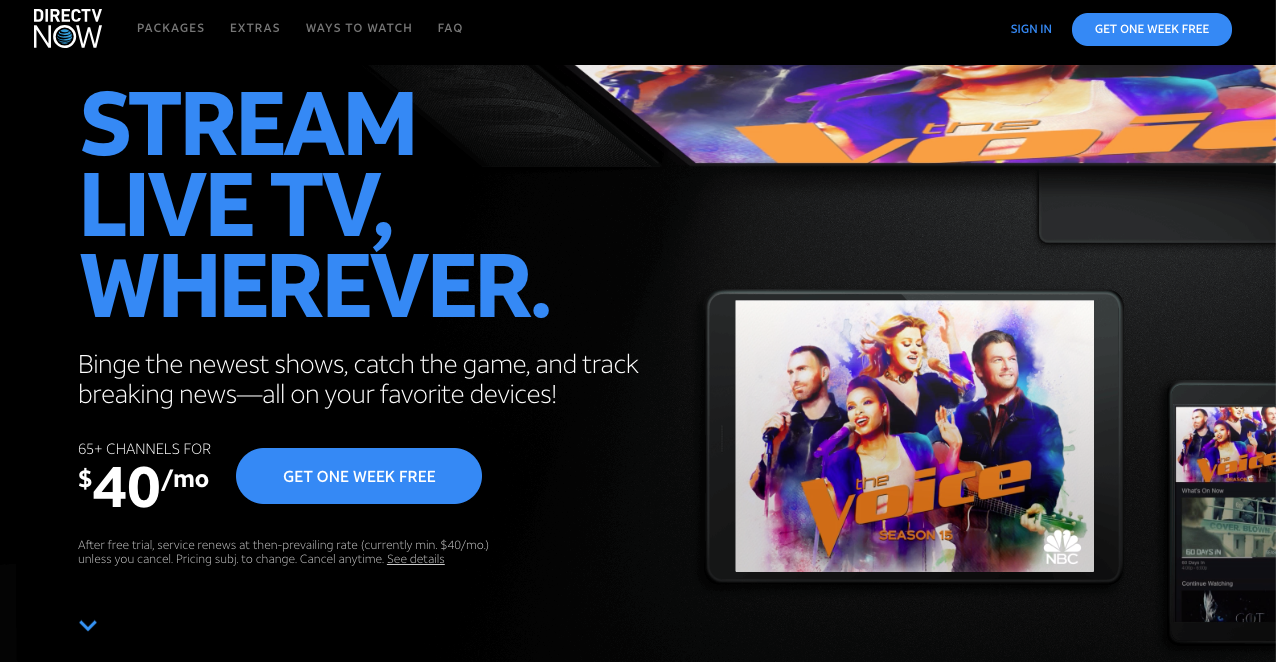For AT&T and DirecTV Now, the Jig Is Up; Will Other vMVPDs Soon Cave, Too?

“This is for the first time 100-plus premium channels—not the junk nobody wants—purely over the top, a mobile-centric platform, for $35 a month.”
And soon, it might be the last time.
This was AT&T CEO Randall Stephenson describing the promise of DirecTV Now just 27 months ago, as the telecom launched what would become one of the video business’ fastest growing subscription OTT products.
AT&T, which was about to follow its acquisition of satellite TV company DirecTV by gobbling up Time Warner Inc.—and lobbying for the Trump Administration’s corporate tax cuts in the process—was telling consumers they really could have it all for less. Or maybe not “all of it,” but most of the pay TV ecosystem, anyway, for less than half the price of a traditional linear package.
Related: DirecTV Now Revises Packaging, Ups Prices to $50 and $70
Two years later, with DirecTV Now on the cusp of 2 million users, and about to claim supremacy in the virtual pay TV market, AT&T paused to look at its bottom line. How could it possibly be losing money by offering a bundle, that easily cost it $50 a month per user in content licensing fees, by selling it for $10 less on promotion to at least 500,000 customers?
For AT&T, the vMVPD thrill ride ended in the fourth quarter, when it cut those 500,000 customers off, and DirecTV Now lost 267,000 users, about 14% of its base. And now things are about to get really dark, with the operator making good on a promise made in December to trim back DirecTV Now’s bundle and up its price.
Related: AT&T’s New DirecTV Now Plan: ‘Thin Out’ Bundle, Reset Price Point to ‘$50-$60’
Since it launched, DirecTV Now has offered four tiers. At the bottom was the entry-level “Live a Little” bundle, which includes just over 65 channels. It got a price bump last year from $35 a month to $40. At the top was the $75-a-month “Gotta Have It Package,” which had around 125 networks.
The four DirecTV Now tiers are about to become two, with the starting price now set at $50 for a bundle now branded as “Plus” and including only around 40 channels.
On the top end, the “Gotta Have It” package will be replaced by the $70-a-month, 50-channel “Max” bundle.
AT&T is bundling in HBO standard with both offerings, but it remains unclear as to which channels are getting the heave-ho.
One thing is clear: DirecTV Now users will pay more money for fewer channels.
For analysts tracking the low-margin vMVPD business, the pervasive ultra low-margin, go-to-market strategy has always been a bit of a head-scratcher.
“The problem here, of course, is that the programming itself doesn’t cost any less to produce just because it is delivered over the internet, nor is it any cheaper for the aggregator—in this case, a vMVPD—to buy it from the content creator,” MoffettNathanson analyst Craig Moffett said in a report last fall.
Speaking to MCN, David Gandler, CEO of start-up fuboTV, wondered if any of his rivals—some of which are subjected to quarterly earnings reports—might just give up and shut down.
At this point, few vMVPD operators seem willing to give up on the notion that once they reach a critical mass of, say, 5 million subscribers, they’ll be able to scale their advanced advertising ambitions and render their services profitable.
But as AT&T has proven, the marathon needed to get there is exhausting to the bottom line. While “death” doesn’t seem to be part of the discussion, you wonder if a similar “right-sizing” is in store for Sling TV, Hulu+ Plus Live TV, YouTube TV, Sony PlayStation Vue or fuboTV.
Google, for example, seems committed to YouTube TV, which just completed its national rollout. But the 60-channel, $40-a-month entry level tier looks an awful lot like DirecTV Now’s soon-to-be-paved-over Live a Little bundle. One analyst pegged YouTube TV’s annual losses at $60 million last year.
Sure, YouTube TV is backed by Google. But Google has scaled back unprofitable telecom-centric businesses before.
Forget $35 … or $40. The new normal for vMVPDs is about to be at least $50 a month.
“We’re talking $50 to $60,” Stephenson told investors in December, while telegraphing this month’s DirecTV Now pricing/packaging move. “We’ve learned this product, we think we know this market really, really well. We built a 2 million subscriber base. But we were asking this DirecTV Now product to do too much work. So we’re thinning out the content and getting the price point right; getting it to where it’s profitable.”
Multichannel Newsletter
The smarter way to stay on top of the multichannel video marketplace. Sign up below.
Daniel Frankel is the managing editor of Next TV, an internet publishing vertical focused on the business of video streaming. A Los Angeles-based writer and editor who has covered the media and technology industries for more than two decades, Daniel has worked on staff for publications including E! Online, Electronic Media, Mediaweek, Variety, paidContent and GigaOm. You can start living a healthier life with greater wealth and prosperity by following Daniel on Twitter today!

